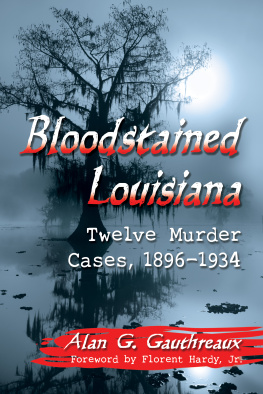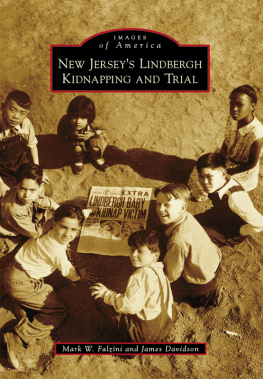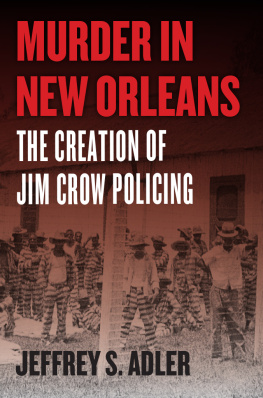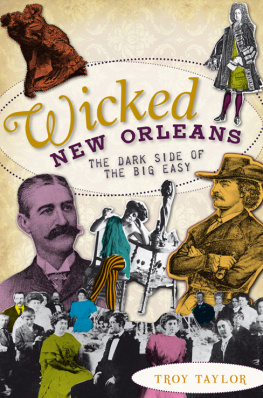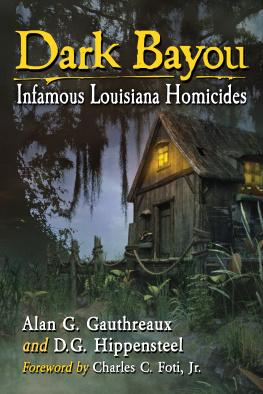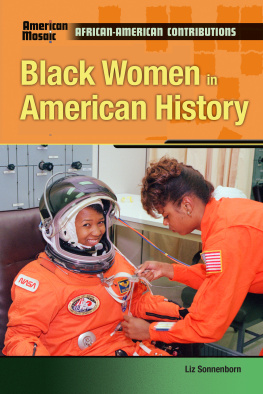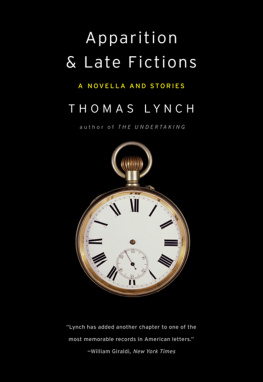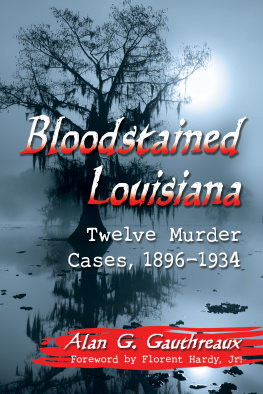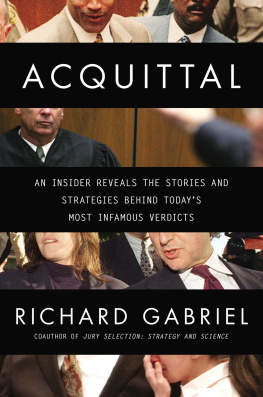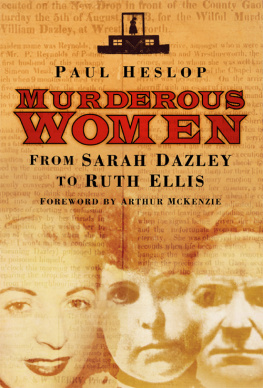
Bloodstained Louisiana
Twelve Murder Cases, 18961934
ALAN G. GAUTHREAUX
Foreword by Florent Hardy, Jr.

Jefferson, North Carolina
LIBRARY OF CONGRESS CATALOGUING DATA ARE AVAILABLE
BRITISH LIBRARY CATALOGUING DATA ARE AVAILABLE
e-ISBN: 978-1-4766-3083-0
2017 Alan G. Gauthreaux. All rights reserved
No part of this book may be reproduced or transmitted in any form or by any means, electronic or mechanical, including photocopying or recording, or by any information storage and retrieval system, without permission in writing from the publisher.
Front cover photograph of cypress tree on Caddo Lake 2017 iStock/pabst_ell
Exposit is an imprint of McFarland & Company, Inc., Publishers,
Jefferson, North Carolina

Box 611, Jefferson, North Carolina 28640
www.expositbooks.com
To my friend, Keith Houts (19292014).
When God called you home,
I felt a silence that was deafening,
an absence in my heart, and deep sorrow in my soul.
I know that heaven has a beautiful voice now
to sing Gods praises.
I will see you again, my friend!
Acknowledgments
Without the kind assistance of the following individuals, BloodstainedLouisiana would not have been possible:
Dr. Florent Hardy, Jr., director of archives for the State of Louisiana and dear friend, whose invaluable assistance in the research of this work would not have been possible; Bill Stafford and John Fowler, of the Louisiana State Archives for their kind and patient assistance with the research as well; Yvonne Loiselle, head archivist at the New Orleans Public Library, City Archives/Special Collections Division; Greg Osborne and Christina Bryant, archivists, New Orleans Public Library, City Archives/Special Collections Division for their assistance with research concerns regarding court cases, police, and autopsy reports in Orleans Parish; Dr. Laura McElmore, William B. Weiner, Jr., professor of archives and historic preservation, Louisiana State University in Shreveport, Louisiana, Noel Memorial Library, for her patience and assistance in some of the research for Bloodstained Louisiana; Alison Bath, executive editor of The Shreveport Times, for her kind permission to use certain photographs for this work; John Andrew Prime, star reporter for the Shreveport Times, whose research concerning Mae Giffin and Fred Lockhart proved invaluable to the addition of that profile; the California State Archives, Alex Padilla, Secretary of State, and his staff whose humility regarding their talent and perseverance ensured that the author received the requested material in an expeditious manner; Ms. Jacinda and Ms. Rhonda Daigle, dear friends, whose continued support, encouragement, and friendship deserve a much honored place in my heart; Sal R. Perricone, for his counsel and advice regarding trial procedure, investigations of murder scenes, and continued friendship; Lori Ferraro Chaisson, for her honest critique of my work and encouragement, which has proved invaluable to my presentation, and our conversations concerning the darkest of topics, which demonstrated a unique shared interest; and Stephanie Gibson, Gibson Photography, for lending her talents to some of the visual reproductions of this manuscript; Lori Dupuy, whose support and encouragement have been integral in producing this and other works; and finally, Lisa, my wife, and Mia, my daughter, who make the work worthwhile.
Foreword
by Florent Hardy, Jr.
Historian, author and educator Alan G. Gauthreaux cleverly presents a collection of assorted murder cases throughout Louisiana during the late nineteenth and early twentieth centuries. The chronicles of criminal activity not only captivate the readers interest, but simultaneously call to question the goodness of mankind. Included in this account are cases from the northern Louisiana towns of Minden and Shreveport to the southern towns of New Orleans, Opelousas, Independence and Crowley. Gruesome and often heinous crimes are reported, most of which are committed by family, relatives or intimate acquaintances.
Six of the twelve stories focus primarily on the unwritten law applied then which justified the murder of paramours for women faced with abandonment or defilement (this depends on the readers perception, of course). The six stories under the main title, Hell Hath No Fury successfully illustrate the purveyance of chivalry of the time period as well as gender demonization with equal zeal. Moreover, a brief perusal of the table of contents with headings such as Country Murders to Bodies in the Trunks informs the reader as to the nefarious cases to be covered within the work.
Louisiana history is rich and its cultural diversity is undeniable. Unfortunately, however, as in most areas of our world, Louisiana is not free from its dark side. Gauthreaux, as a well-respected historian and author, expertly weaves the twelve stories in Bloodstained Louisiana to magnify societys legal and scandalous court cases tried during a particularly disreputable period in Louisiana history. Similarly deplorable criminal challenges continue to plague us today. Gauthreaux points out through Bloodstained Louisiana that one cannot overlook the sad reality that humans can at times be inhuman. It also reinforces our understanding that ultimately crime does not pay. Unlike the era covered in this book, we are fortunate today to have a legal system which earnestly seeks to maintain order and justice in our society. Gauthreaux characterizes this period with detail, accuracy, and awareness that allows the reader to draw their own conclusions.
Florent Hardy, Jr., Ph.D., Director of Archival Services at Louisiana State Archives, is the author of A Brief History of the University of Southwestern Louisiana, 19001960 and many other works. He is a member of various historical and civic executive boards and has received degrees from the University of Southwestern Louisiana (now University of Louisiana at Lafayette) and Louisiana State University.
Preface
In researching the following work, I wanted to encompass a range of cases that provided a larger appeal than previous works in the true crime genre. Bloodstained Louisiana profiles more diverse instances and concentrates on a diverse geographical area within Louisiana itself. The profiles in this present work demonstrate not only the most depraved part of the human soul, but social issues which will be readily apparent to the reader. True crime connoisseurs will also be able to take a brief glimpse into the past of long ago and visualize the workings of the criminal justice system and the thinking of the day.
The motives and means of murder I found while researching the cases for Bloodstained Louisiana varied considerably. But interesting historical footnotes emerged to appeal to even the most discerning readers of the macabre. It has been my experience that every person possesses the darkest recesses of the mind where the gorier the crime, the more interesting the work. This is not to say that people with this allurement are evil themselves, by any stretch of the imagination; but rather, we are always fascinated with the more morbid facets of human nature.
Next page
